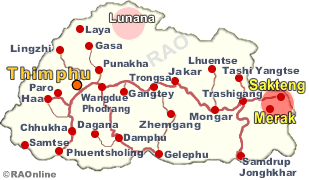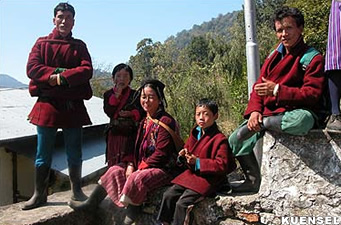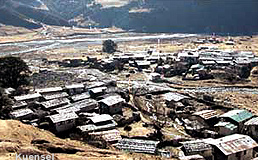 |
Bhutan's
Festivals Tshechu |
 |
Bhutan Information |
|
|
 |
|
Khaling:
Tshechu for the Brokpas (Merak and Sakten)
|

|
 |
| Dawn
has not yet broken and 40-year-old Zangmo has finished her household chores.
Quickly sending off the yaks to graze she and her family, attired in their
best costumes, set off for Khaling, Trashigang, on foot.
After
a two-hour descent through pine forests they reach Tsendar Dubzhi, where
the Khaling tshechu is being held. Friends and relatives from the nomadic
Brokpa community of Merak and Sakten who are already there greet them. |
|
The
Khaling tshechu is unusually popular among the Brokpas. In fact, Khalingpas
say that it is the only tshechu that the majority of the brokpas from Merak
and Sakten witness. "This is the only tshechu me and my children have attended
in our life time," said Zangmo. "Forget about other places, we cannot even
make it to Trashigang tshechu because of the distance and the expenses
involved".
| THE
TSHECHU |
 |
 |
| The tshechu is popular with the highlanders |
| Chams
(religious dances) like the Peling Rigsum, Drametse Ngachham, Sha Zam,
and Chug Zam are performed and the thongdroel bearing Tenpa with Chagtong
Chentong and Guru Rinpoche is displayed on the last day of the tshechu.
Lobzang,
a father of two, said that except for the occasional business trips, they
could not really stay back for the tshechu in other places.
However,
it was convenient for the Brokpas to attend the Khaling tshechu as it coincided
with their migration to the warmer valleys in winter. Khaling was a couple
of hours walk from where they pitched camp. |
|
"As
we are much nearer to the place, we can take our children along who needs
exposure and blessings," said Lobzang.
Many
said that there were religious performances like Acha Lham and Yakchham
back in the village but never a tshechu with complete set of performances.
While
most of the families brought packed lunch and returned in the evening to
their herds, some pitched tent near the Lhakhang and stayed until the last
day of the tshechu.
Some
also took the opportunity to sell cheese, butter, and yak meat. "We can
sell more of our produce during the tshechu," said 34-year-old Dorji Tashi
of Merak.
According
to Khaling chimi, Sonam Dorji, the tshechu was previously held in August
but was later shifted to October to correspond with the migration of the
Brokpas.
 |
| Sakten town |
| He
said that earlier there was an agreement with the yak herders that they
would come down in the month of September and return to their villages
some time in April.
"This
arrangement gave Brokpas an opportunity to attend the tshechu," he said,
adding that the tshechu timing was also altered because it earlier fell
during the time of 'La Dham'. "It is believed that one is not supposed
to travel to the hills as it disturbed the deities and brought rain that
destroyed crops," he said. |
|
Meanwhile,
Sonam Dorji said that there were at least 30 Brokpas attending the tshechu
in a day.
"Some
come here to establish businesses but most are drawn by the tshechu," he
said, adding that Brokpas also made offerings in the form of butter and
cheese.
 |
| Contributed
by Kesang Dema, KUENSEL, Bhutan's national newspaper, 2006 |
| Information on Bhutan |
 |
|






